Safari’s very first prehistory toob is charming, but largely showing its age in the details and aesthetics of the figurines.
Toobs might be the unsung heroes of Safari Ltd.’s toy lines. I see them wherever Safari products are sold, even when their larger, standard-sized kin are absent. Among the numerous Toobs released have been several focused on prehistory, and they all started with the original Dinos Toob. For this review, I’m looking at two different copies of the Toob in question. Safari has made some changes to production since the first release, so I think it’s worth noting them for reference’s sake.
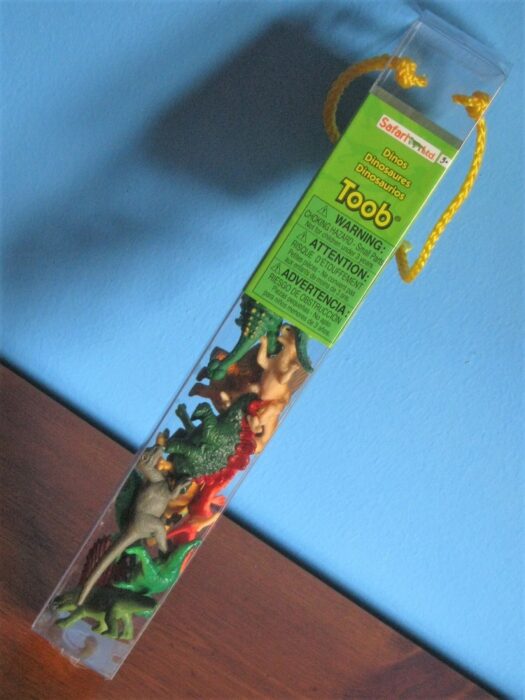
Like all Toobs, the Dinos come in a tall, rectangular, clear plastic tube, with non-foldable flaps at the top and a plastic rope to carry or hang it up with. Older Toob releases came with a nifty plastic lid with a built-in globe capable of spinning. While this lid was admittedly poor at staying on once unsealed, I do miss the extra flourish Safari used to give the packaging.

Back when Safari divided its prehistoric figures between the Carnegie Collection and the Wild Safari line, the latter tended to hit a rough middle ground between scientifically accurate toys and stylized play toys. The Dinos Toob, having been around for at least a decade now, leans firmly in the stylized camp. Let’s look at the classic Tyrannosaurus first. Posed rearing up in classic John Sibbick fashion, the Toob rex is light on anatomical details, with emphasis on the animal’s large head and teeth, plus a rounded, bulky body. The coloration of the original release – light lime green turning to dark blue-green, with yellow stripes along the back – is reminiscent of the old Carnegie Tyrannosaurus. I’m sure this was deliberate for sake of continuity between Safari’s toy lines. The newer release has a more basic, saturated green coloration, which honestly makes it less striking. It’s worth noting that the newer releases have the dinosaur’s names on them, whereas the older figures are merely marked copyright of Safari Ltd., “CHINA”.

Diplodocus, one of the larger figures in the Toob, is portrayed as lean and lively – perhaps a bit too lean, as its ribs and collarbone are showing. The head is held high, which is a position of debate in paleontology, but potentially more accurate this way as of this writing. Sculpt details are light here, with a sandy brown color to the whole figure. the original version also bears green mottling across the back and neck, while the newer version lacks the green, instead having a more saturated orange hue.
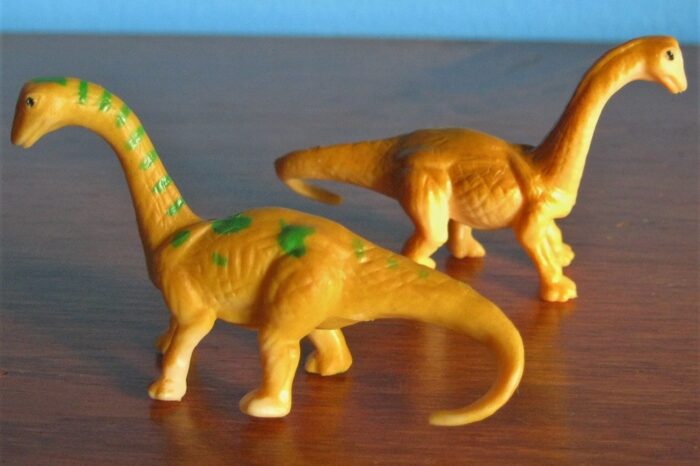
Velociraptor is also portrayed in a lively manner, with arms and body raised for action, even though it is now stuck in a tripod position. Safari did make sure to accurately capture the narrow skull shape of the genus, but all other features are stubby and rounded off. There are, of course, no evident feathers on this figure, as it predates evidence of feathers on the genus. The dull brown and gray coloration has been unchanged between new and old versions of the figure, apart from individual application.
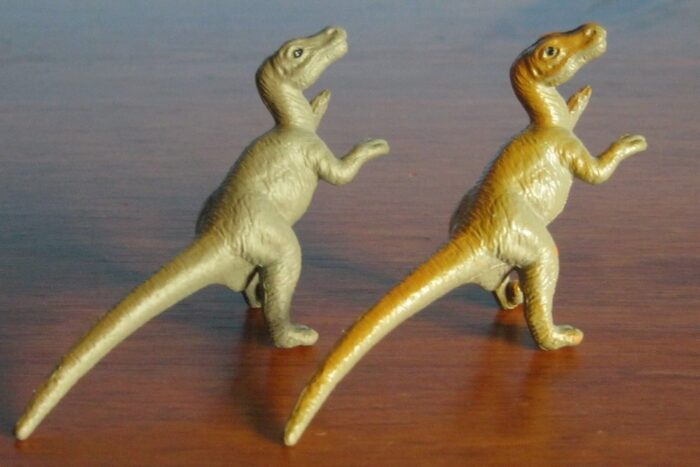
Stegosaurus charmingly follows its old Carnegie counterpart in chunky, low-slung form, with a big “smile” to boot. A row of studs/scutes follows the plates down both sides of the body, highlighted with red on the original figure’s bright green and orange color scheme. The newer version is colored a flat, dark green and red, which I think is possibly the most egregious downgrade of a color scheme in this set.
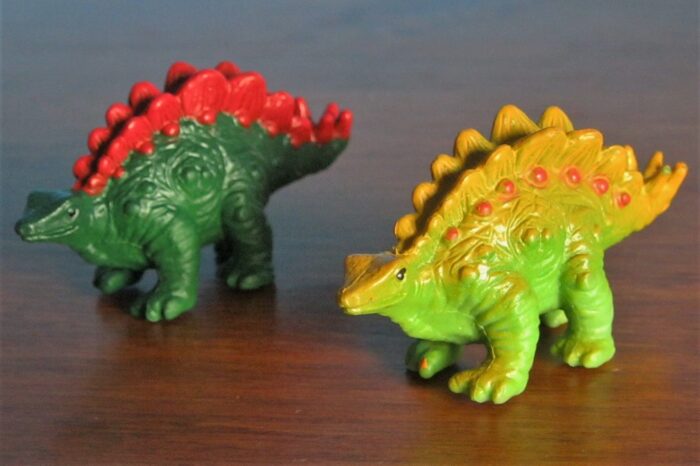
Spinosaurus might be the (second) most outdated figure in this Toob, standing upright with a big, boxy head. However, the Spino does have scale highlights sculpted into the back, and while they really shouldn’t be showing, the skull does feature distinct fenestrae. Like Diplodocus, Spino is mostly painted light sandy brown; the newer version stays the same, albeit in a darker tone.
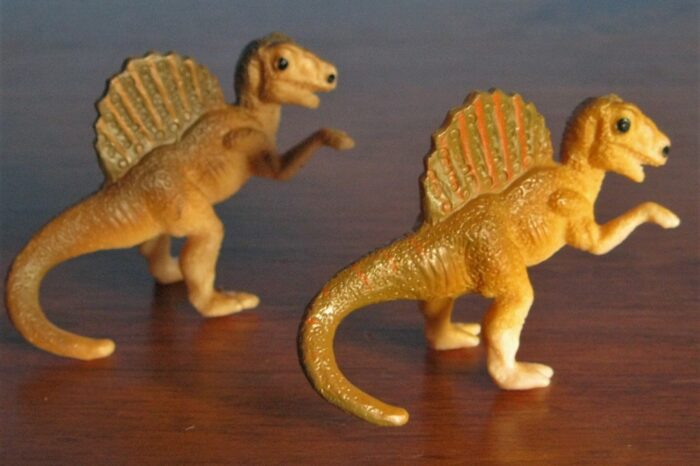
Ankylosaurus holds up better than most of the other figures – although it might be more accurate to the genus Euoplocephalus, ultimately. Posed mid-stride, covered in bony scutes, this Ankylosaurus is rather more realistic in overall portrayal. Both the original and newer versions are painted primarily green, with yellow highlights to the middle scute rows.

Safari did sneak in two non-dinos for the Toob – one of which is the sail-backed synapsid Dimetrodon. This mini-figure might actually be a little ahead of its time, with its body fully raised and its legs mostly tucked under the body, instead of sprawled low like traditional (stereotypical) reptilian depictions. Painted flat green and red, the new and old versions are mostly indistinguishable – although my newer version lacks some spots on the sail and is less glossy.

The pterosaur Pteranodon is the second non-dinosaur in the Toob, depicted in typical “flappy-bird” style seen in many older figures. Honestly, I’m at a loss of what else to say about this one; it’s easily recognizable by its crest, but its details are fairly generic for a pterosaur otherwise. This is perhaps the flimsiest figure in the Toob. Newer releases have enhanced the figure’s reddish hues to an almost raw meat color, as opposed to the more natural and neutral tones of the original.
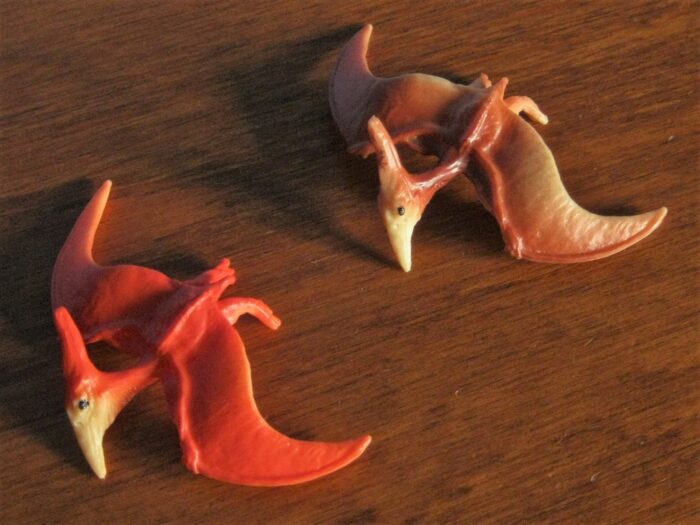
Iguanodon is probably the best figure here, with a generally accurate outline and nice scale details across a sturdy-looking body; oddly, though, the signature thumb spike isn’t very present. The figure is colored bright green and blue, with the newer version taking a slightly darker hue in its striping.

Dilophosaurus is a personal favorite genus of mine, so I have several of these Toob figures, bought within the Toobs and individually at stores. Although the figure is very soft on details, it does retain that delightful snarly look of the jaws. Both new and old versions are colored in alternating blue/green and yellow patterns; like the Velociraptor, variations depend mostly on individual application.
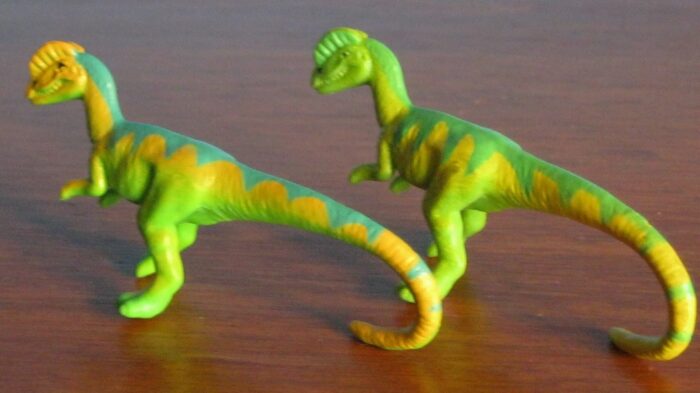
Triceratops returns to the chunky, old-school style of the earlier figures, with elephantine wrinkles and warty scutes on the backside. Both new and old versions maintain a green coloration with yellow frill, but one thing I’ve noticed when comparing my figures (and others in this Toob) is that many of the older ones have more precise coloration for the eyes. I can’t help feeling Safari is getting sloppier with their minis overall.
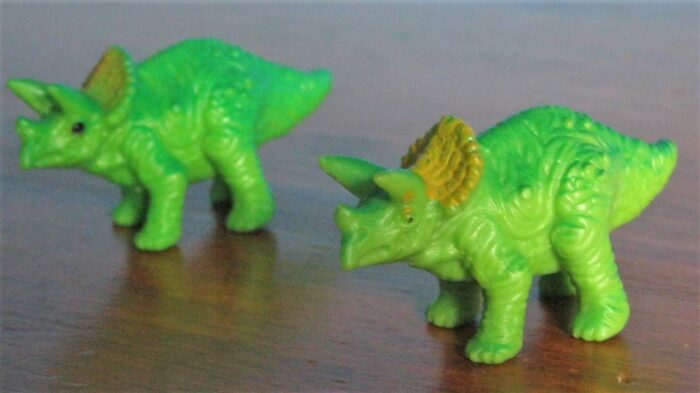
Last of the figures is Apatosaurus – or maybe I should say Brontosaurus, for how very old-school this rendition is, maxing out the cute, dumpy toy shape of retro sauropods. I sadly lost my first copy of this figure, but the newer version is unchanged in appearance, other than some subtle differences in color saturation.
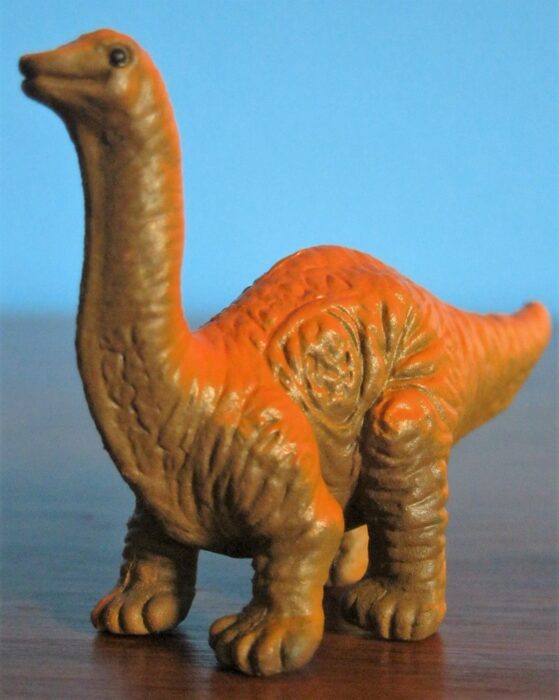
While I might sound very critical above, Safari’s Dino Toob is certainly charming and a great item for kids. However, the fact remains that it is well below the new standard Safari has set for themselves; thus this set is rather obsolete. Hopefully, in the near future, Safari Ltd. will renovate its “classic” toob with new, up-to-date miniatures; in the meantime, you can pick this Toob up on Amazon, various online dinosaur shops, and . . . well, probably just about anywhere.
Support the Dinosaur Toy Blog by making dino-purchases through these links to Ebay and Amazon. Disclaimer: links to Ebay.com and Amazon.com on the The Dinosaur Toy Blog are often affiliate links, when you make purchases through these links we may make a commission

Thanks for the review. About 30 years ago I bought three dinos of the original line (Triceratops, T-Rex and Brontosaurus). In Germany I think they were imported by Schleich at this time. They are not accurate but still charming. Yesterday I have ordered the tube ˋSue and her friends ´. I am tuned to compare them. ;-D
I have the Dino toob ,and the sue and her friends toob this is the toob that has the dinos with colorful dots on them . This is not the regular Dino toob right?
Nope. Sue & her friends is a different toob, although it mixes figures from this toob with those of the Carnivorous Dinos toob.
In my opinion,the colour scheme of the oldest small Safari figures(that series wasn’t sold in tubes in Hungary) was better than any one of the article.
Among them, the Apatosaurus is Brontosaurus and the Ankylosaurus is Euoplocephalus.
I had those toys on a volcano birthday cake
They retired the Prehistoric Sharks, Crocodiles and Sealife Toobs over this? (And they also spared this one from a complete butchering of its paint jobs, unlike the Feathered Dinos Toob).
Although for it’s size, I actually think the Dilophosaurus isn’t as ugly as the large version.
Don’t forget the Cambrian Life Toob. Maybe the interesting Toobs just don’t sell for them.
I love these figures. They often make great stand-ins as “babies” of larger figures. And the Dilophosaurus is my favorite, too!
A very mixed bag with this toob. I do really like the Iguanodon and Dilophosaurus figures here, they’re a nice mix of cute and accurate.